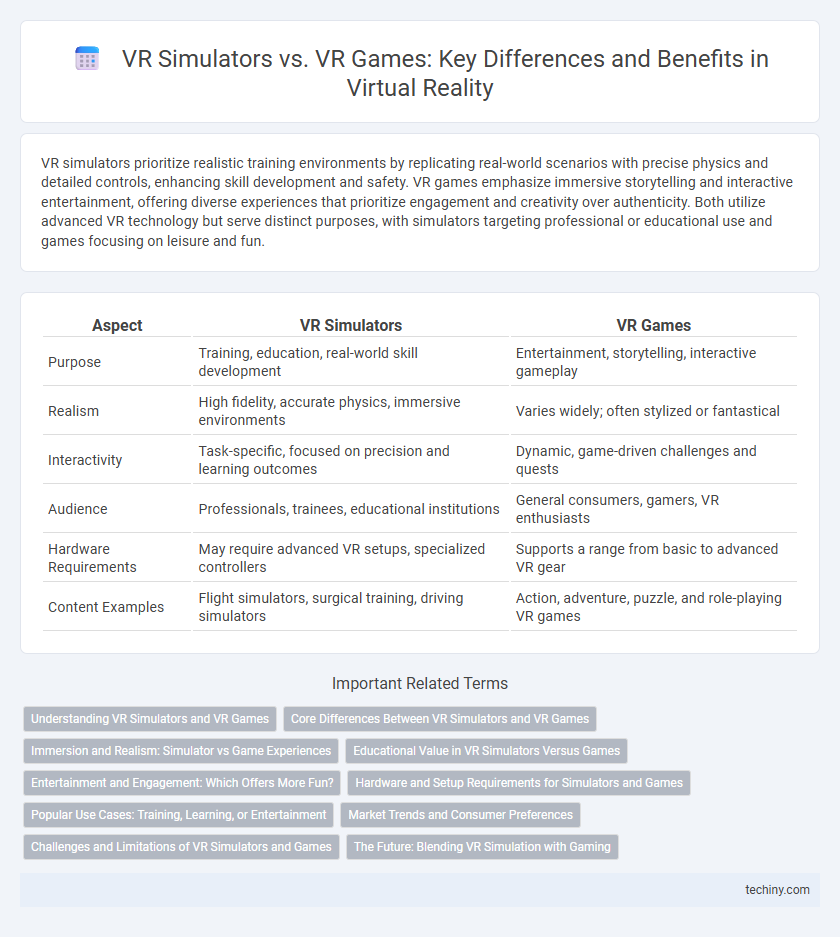VR simulators prioritize realistic training environments by replicating real-world scenarios with precise physics and detailed controls, enhancing skill development and safety. VR games emphasize immersive storytelling and interactive entertainment, offering diverse experiences that prioritize engagement and creativity over authenticity. Both utilize advanced VR technology but serve distinct purposes, with simulators targeting professional or educational use and games focusing on leisure and fun.
Table of Comparison
| Aspect | VR Simulators | VR Games |
|---|---|---|
| Purpose | Training, education, real-world skill development | Entertainment, storytelling, interactive gameplay |
| Realism | High fidelity, accurate physics, immersive environments | Varies widely; often stylized or fantastical |
| Interactivity | Task-specific, focused on precision and learning outcomes | Dynamic, game-driven challenges and quests |
| Audience | Professionals, trainees, educational institutions | General consumers, gamers, VR enthusiasts |
| Hardware Requirements | May require advanced VR setups, specialized controllers | Supports a range from basic to advanced VR gear |
| Content Examples | Flight simulators, surgical training, driving simulators | Action, adventure, puzzle, and role-playing VR games |
Understanding VR Simulators and VR Games
VR simulators replicate real-world environments with precise physics and interactive elements designed for training, education, or professional use, such as flight simulators and medical training modules. VR games emphasize immersive entertainment experiences, featuring diverse genres, storytelling, and interactive gameplay to engage users in virtual worlds. Both utilize VR technology but differ fundamentally in purpose, design, and user engagement, with simulators prioritizing realism and skill acquisition while games focus on fun and exploration.
Core Differences Between VR Simulators and VR Games
VR simulators prioritize realism and training accuracy by replicating real-world scenarios with precise physics and interactive environments, often used in industries like aviation and healthcare. VR games emphasize entertainment, creativity, and user engagement through imaginative worlds, gameplay mechanics, and story-driven content. The core difference lies in simulators' focus on skill development and practical application, while VR games focus on immersive leisure and interactive storytelling.
Immersion and Realism: Simulator vs Game Experiences
VR simulators prioritize high-fidelity replication of real-world environments, using precise physics and detailed scenarios to enhance immersion and realism for training or professional purposes. VR games often emphasize engaging narratives and interactive entertainment, balancing immersive elements with creative design rather than strict realism. The simulator experience delivers a more authentic sense of presence through accurate sensory feedback, while VR games focus on dynamic interactions and player agency within virtual worlds.
Educational Value in VR Simulators Versus Games
VR simulators offer immersive, interactive experiences designed to replicate real-world scenarios for practical skill development, making them highly effective for educational purposes in fields such as medical training, aviation, and engineering. VR games prioritize entertainment but can incorporate educational elements through problem-solving, storytelling, and cognitive challenges, though their learning outcomes are generally less structured than simulators. The targeted, scenario-based nature of VR simulators leads to more measurable knowledge retention and skill acquisition compared to the broader, often less focused experiences provided by VR games.
Entertainment and Engagement: Which Offers More Fun?
VR games prioritize immersive storytelling and interactive challenges to maximize entertainment, leveraging advanced graphics and dynamic gameplay that captivate players for extended periods. VR simulators focus on realistic environments and precise controls to replicate real-world experiences, offering deep engagement through skill development but often less spontaneous fun. For pure entertainment and excitement, VR games typically provide more diverse and enjoyable experiences, whereas VR simulators cater to users seeking practical learning combined with moderate engagement.
Hardware and Setup Requirements for Simulators and Games
VR simulators demand high-end hardware configurations, including specialized motion platforms, haptic feedback systems, and precise tracking sensors to replicate realistic environments accurately. In contrast, VR games typically require less complex setups, often running smoothly on consumer-grade headsets like Oculus Quest or HTC Vive with basic controllers. The extensive physical space and calibration needed for simulators surpass the more flexible, room-scale or seated experiences common in VR gaming.
Popular Use Cases: Training, Learning, or Entertainment
VR simulators excel in training and learning environments by providing realistic, immersive scenarios that enhance skill development and knowledge retention, commonly used in pilots' flight training and medical procedure practice. VR games focus primarily on entertainment, offering interactive experiences with engaging storylines and dynamic gameplay that appeal to a broad audience. Both VR simulators and games leverage virtual environments but are optimized for different purposes, with simulators prioritizing accuracy and realism for professional use.
Market Trends and Consumer Preferences
VR simulators are increasingly adopted across industries such as training, healthcare, and engineering due to their realistic, task-specific environments that enhance skill acquisition and safety. In contrast, VR games dominate the consumer entertainment market by offering immersive storytelling and interactive experiences tailored to diverse gaming demographics. Recent market trends indicate a growing preference for simulators in professional development, while consumer demand for VR games continues to soar with advancements in graphics and accessibility.
Challenges and Limitations of VR Simulators and Games
VR simulators face challenges such as hardware costs, motion sickness, and limited sensory feedback that restrict immersive realism. VR games often struggle with latency issues, graphical fidelity, and balancing interactive complexity with accessibility for diverse user skill levels. Both applications encounter limitations in content variety and long-term user engagement due to technological and design constraints.
The Future: Blending VR Simulation with Gaming
VR simulators and VR games increasingly converge as advancements in haptic feedback, AI-driven environments, and real-time physics create immersive experiences that blur training and entertainment boundaries. This fusion enables lifelike scenarios where users can simultaneously develop practical skills and enjoy engaging gameplay, enhancing both learning outcomes and player satisfaction. Emerging platforms leverage cloud computing and multiplayer connectivity to deliver scalable, adaptive VR worlds that dynamically adjust to user inputs for personalized, interactive immersion.
VR Simulators vs VR Games Infographic

 techiny.com
techiny.com